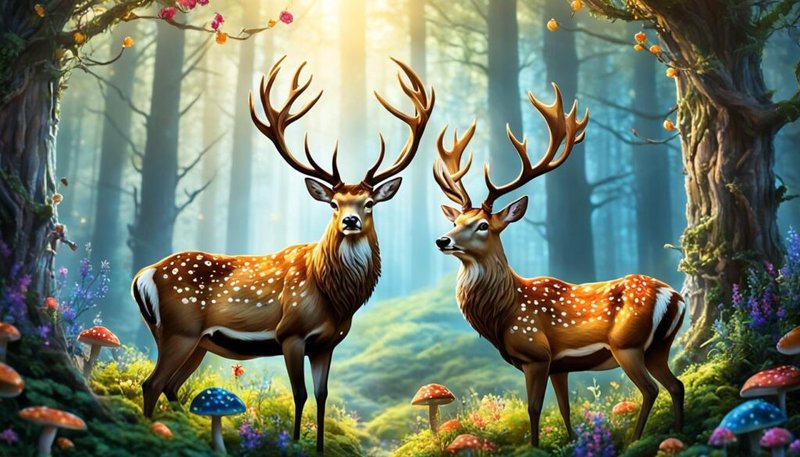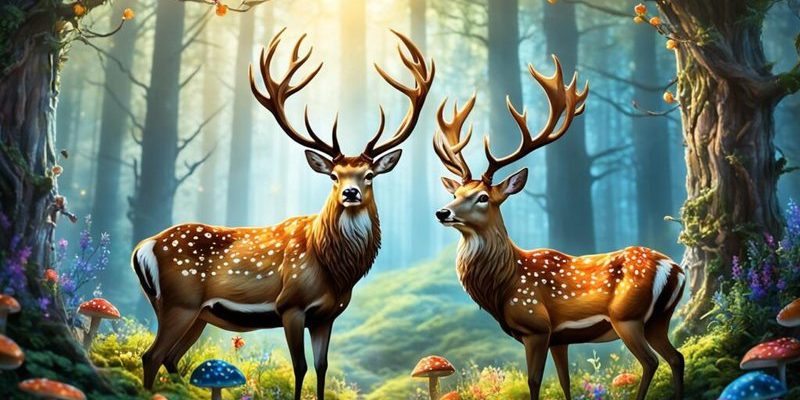
In many cultures, deer hold a unique place. They often represent different qualities or attributes, from nurturing and gentleness to power and nobility. When we dig into various cultures and their stories, we find that red deer aren’t just animals; they’re also characters in legends, symbols of beliefs, and even messengers of the divine. So, let’s take a stroll through some fascinating cultural narratives where red deer appear, shall we?
The Red Deer in Celtic Mythology
In Celtic mythology, red deer often take on a mystical role. The Celts viewed the deer as spiritual guides between this world and the next. One famous tale is that of the White Stag, a legendary creature said to be a harbinger of change. Encountering this stag was seen as a call to embark on a personal quest or journey.
The deer’s ability to move through both forests and mystical realms made it a symbol of transformation. In stories, pursuing the stag often led to valuable insights about life, love, or destiny. Think of it like following a breadcrumb trail that leads you to uncover hidden truths about yourself or your surroundings.
Moreover, the presence of deer in Celtic artworks and carvings highlights their importance. Their graceful forms elegantly depicted in stone, remind us that these creatures were deeply respected and revered.
Representations in Norse Mythology
Switching gears to Norse mythology, deer also hold a significant position. One notable figure is Eikþyrnir, the great stag residing atop Valhalla, the hall of the slain warriors. Eikþyrnir is said to nourish the roots of the world tree, Yggdrasil, and symbolize life and rebirth.
In Norse beliefs, deer aren’t just animals; they represent the connection between life and the afterlife. They embody strength and resilience, qualities that the Norse people admired. The stories surrounding Eikþyrnir show how intertwined nature is with spirituality in scandinavian mythos.
Moreover, the antlers of the stag are often seen as a connection to the cosmos. They symbolize the branches of the Yggdrasil, emphasizing the idea that all life is interconnected. It’s almost as if the antlers reach out toward the heavens, reminding us that we are all part of something greater.
Red Deer in Native American Culture
For many Native American tribes, the deer is a symbol of grace, gentleness, and love. The red deer, or elk as they are often referred to, plays a crucial role in stories and rituals. They are seen as messengers carrying wisdom from the spirit world to the human realm.
In some tribes, there are tales of the deer offering its life for human survival, teaching the importance of gratitude and respect for nature. This selfless act reflects a deep connection with the land and all its inhabitants. When you hear these stories, you might feel a pull to appreciate the animals around you and the balance they maintain in ecosystems.
Additionally, many Native American artworks feature deer, symbolizing the beauty and harmony of nature. They often remind listeners to tread lightly on the earth and honor the life that sustains us.
The Role of Red Deer in Modern Folklore
As we transition into modern times, red deer still capture our imagination. They appear in various forms of art, literature, and even film. In contemporary storytelling, these animals are often depicted as guardians of the forest, embodying wisdom and tranquility.
One popular example is in children’s literature, where deer are often portrayed as friendly forest dwellers who help lost travelers or give wise advice. This warm portrayal reinforces the idea that nature is nurturing and that animals can teach important life lessons.
Movies like “Bambi” also explore these themes, portraying deer as innocent beings in a world filled with challenges. Through these narratives, viewers learn about friendship, loss, and the beauty of coming of age. The red deer, in these tales, becomes a symbol of growth and resilience.
Symbolism of the Red Deer in Art
Red deer have made their mark in various artistic expressions throughout history. From ancient cave paintings to contemporary sculptures, these animals inspire creativity and convey messages about life and the natural world.
Artists often use the deer’s form to symbolize grace and beauty. The delicate lines of a deer’s silhouette can convey both softness and strength, making it a popular subject for painters and sculptors alike. You might find deer in artworks that celebrate the changing seasons, reminding us of nature’s rhythms and cycles.
Furthermore, red deer often appear in heraldry. Many families and organizations use the deer as a symbol of nobility and strength. It’s almost like wearing a badge that communicates values of honor and connection to nature.
Ecological Representation of Red Deer
Beyond cultural narratives, red deer also symbolize ecological balance. They play a vital role in their habitats, influencing plant growth and maintaining the health of forests. This ecological aspect can be seen as a reflection of the interconnectedness depicted in many cultural tales.
Their grazing habits help shape the landscape, allowing various species to thrive. Consider the deer as nature’s gardeners—they prune and nurture the ecosystems they inhabit. This concept of nature’s balance echoes through folklore, showcasing not just the aesthetic beauty of red deer but also their role as vital contributors to their environments.
Recognizing this role helps us understand the importance of conservation. Protecting red deer and their habitats is crucial for maintaining the delicate ecological balance that supports countless life forms.
The representation of red deer in culture and folklore reveals how deeply intertwined these creatures are with human beliefs and values. From ancient mythologies to contemporary storytelling, red deer serve as symbols of strength, transformation, and connection to the natural world.
Their stories echo through time, reflecting our collective understanding of the environment and our place within it. Whether it’s a tale of a Celtic hero chasing a mystical stag or a modern story that teaches children about friendship, the legacy of red deer continues to inspire.
As we reflect on these narratives, we gain not just insight into the red deer but also a deeper appreciation for the natural world and its role in shaping our cultural landscapes. So next time you see a deer, remember the rich stories and meanings they carry with them—they’re more than just beautiful animals; they’re part of our shared human experience.

